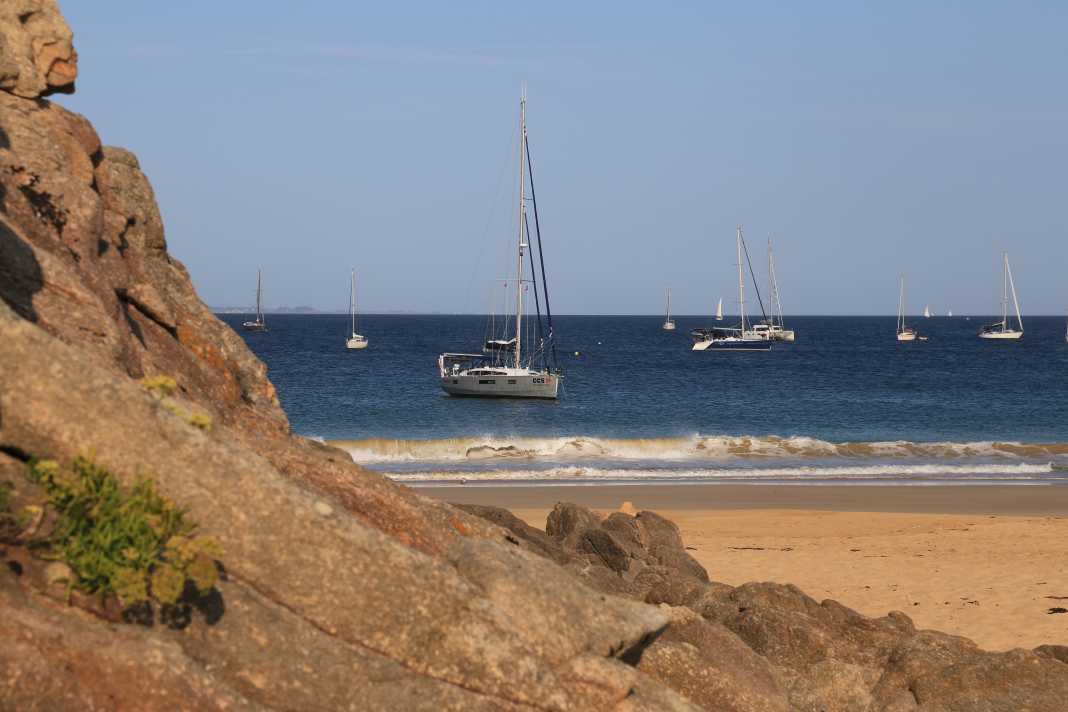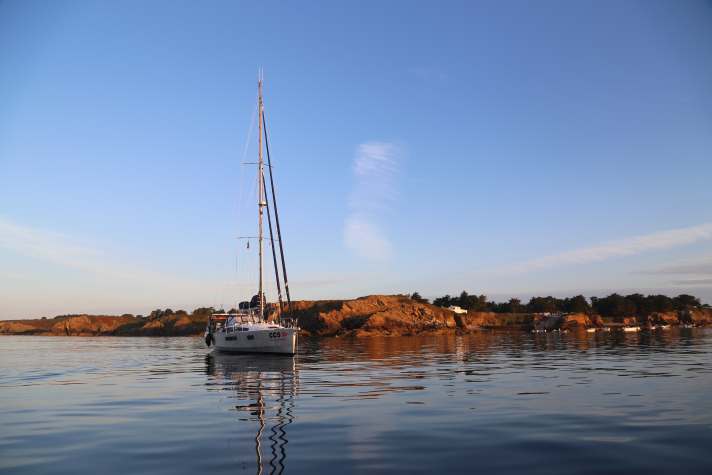Brittany: Against current and wind - from Les Sables D'Olonne to Pornichet
Jill Grigoleit
· 31.10.2025






Southern Brittany is one of Europe's top sailing destinations. Fantastic anchor bays, charming fishing villages with Breton flair and culinary highlights. In terms of sailing, the tidal area is challenging and offers a unique mix of coastal and offshore sailing. We travelled with the Cruising Club of Switzerland (CCS) in perhaps the most beautiful sailing area in France.
One last small wave, a gentle jolt and we sit up with the stern. Only the bow facing away from the beach is still moving slightly in the receding surf. I look down from the bathing platform into the crystal-clear water below me and estimate the water depth at waist height. The water will still flow out a few centimetres, low tide isn't for another hour. We still won't get ashore completely dry. But we don't have to launch the dinghy today. We take a 45-foot yacht directly to the beach. What an experience.
The pearl of Brittany
In front of us lies the two-kilometre-long fine sandy beach, which is still deserted in the morning. But when I turn round, I see white masts as far as the eye can see. Around a hundred other anchormen have spent the night with us in the bay. It's early August and high season in Brittany. The Plage du Gouret on the Île d'Houat, also known by its unpronounceable Breton name Treac'h er Goured, is the pearl of Brittany: clear turquoise water, white sand and an unobstructed view of the undeveloped dune landscape beyond. An anchoring dream like in the South Seas - only with a lower water temperature, as I realise when we wade through the waist-high water to the beach with our rucksacks on our heads.
I am travelling for a week with a motley crew from the CCS, the Cruising Club of Switzerland. With around 5,500 members, the sailing club based in Bern is one of the largest water sports clubs in Switzerland and is one of the country's leaders in offshore training. Piero has been sailing for the club for over 35 years and as a skipper for a good 20 years, and has already completed several trips in this area. Brittany is his absolute favourite sailing area. "It's simply beautiful here. And it's also exciting sailing because we not only have the wind, but also the tides, which we have to take into account when planning our navigation. We know in advance where we'll get the boat and where we'll drop it off. But there's a week in between, during which a lot can happen and we have to adjust to low tide, high tide and wind conditions."
Famous godmother and sailing mecca
We started four days ago in Les Sables d'Olonne, the birthplace of the latest addition to the club's fleet, a brand new OVNI 450 from the French company Alubat. After her christening in May - with Justine Mettraux as godmother - the Cruising Swiss VI started her first season this summer. When we arrive in the home harbour of the world's toughest single-handed sailing regatta, the huge images of the winners of the Vendée Globes of the past decades smile at us from a wall in the hall. The city is a sailing mecca. But we don't stay here for long. Because in the first two days we want to make as much distance as possible to the north despite unfavourable wind conditions. Our destination is the beautiful island world of southern Brittany, one of the most popular, but also navigationally more challenging sailing areas in France. The tidal area is characterised by sometimes strong currents, although not as extreme as in northern Brittany and in the transition to the English Channel.
Against wind, current and calm
Sailing northwards here means crossing frequently in the prevailing north to north-westerly winds. What's more, the current is also working against us. At the beginning, we make a maximum of four knots over ground. We pass rugged stretches of coastline and fine sandy beaches. Steep cliffs alternate with dune landscapes. We sail a long, northward beat close to the wind, as far as we can, until our first destination, the Île d'Yeu, lies off the port side. When we finally head for the Anse des Vieilles anchorage, it is already 8 p.m. and the bay is pretty full, but we still find a spot on the edge. The already weak wind dies down completely overnight. We have a quiet night at anchor, but sailing is out of the question the next morning. The Atlantic is as smooth as glass in front of us as a lake. The scenery, however, is breathtaking. The reddish rocks are illuminated by the rising sun, absolute silence lies over the bay.

After a refreshing swim in the ice-cold water, we decide: The north-westerly course to the Belle Île we were actually aiming for is unsailable and too far under motor. Instead, we head for Pornichet. We motor along the never-ending wind farms for hours. I had imagined a sailing trip on the Atlantic differently. The oilskins stay below deck. But: plenty of sunshine, blue skies and dolphins. Lunch in the cockpit under autopilot is correspondingly relaxed. There are worse things.
Manoeuvre training on the Atlantic
In the afternoon, the wind picks up a little and turns to the west. We set the main and genoa and set sail. At last. Despite the opposing current, we make more speed than yesterday. At around six knots over the ground, we sail a pleasant half-wind course. That works.
Suddenly the command "Man overboard". A brief shock, a glance aft, relief: a fender is floating in the wake. Our skipper Piero smiles: "It wouldn't be a real exercise if I announced it!". Training is always part of the CCS trips. While the focus is on training on the pure training and manoeuvre trips, the holiday trips are primarily about having fun sailing, but training is always part of the daily routine. Starting with the day's planning the evening before, where navigation and tide tables are practised, right through to the MOB manoeuvre. One after the other, all five of us complete the manoeuvre with flying colours and we move on.
We reach Pornichet in the evening. When planning our navigation for tomorrow, we realise that we have to get up early to catch the westerly wind that was forecast at the beginning of the day, which is expected to die down by midday and turn to the northwest. We want to reach Belle Île before 3 p.m., as there is only a one-hour window at high tide when the lock to the inner harbour is open. So we cast off at 7 a.m. the next morning and motor out of the harbour towards the west with the rising sun behind us.
The Club:
The club The Cruising Club of Switzerland has around 5,500 members. Swiss citizenship or residence in Switzerland are not prerequisites for membership. The fleet consists of five sailing ships and one motorboat, which are used from the Mediterranean to the Gulf of Finland. In addition to cruises, there are also training cruises, themed cruises, milestone cruises and transfer cruises. More information: www.cruisingclub.ch/de Contact: Phone: +41 31 310 11 00 Mail: info@cruisingclub.ch
The boat:
The Cruising Swiss VI is an OVNI 450 from Alubat in Les Sables-d'Olonne, 45 feet with lifting keel. The aluminium folding chandlery has proven itself on long voyages and in tidal areas. This model is the first to have two steering wheels in the cockpit.
Precinct information:
Wind & weather: The prevailing winds are mostly from the west to north-west. It can quickly become rough with low pressure from the Atlantic.
Navigation: Good lighting, but some shallows, barre entrances (e.g. at river mouths) and strong tidal currents require careful navigation. Harbours: There are countless anchorages along the Breton coast as well as well-equipped marinas. It can get very busy in high season and you should book in advance, especially in Le Palais harbour: VHF channel 9 or Tel: 02 97 31 42 90.
Literature:
- Atlantic France, Nick Chavasse, 63.50 euros, ISBN number: 9781786793744, www.nv.charts.com
- Bloc Marine: Atlantique, 36 euros, ISBN: 9782958016043, provides valuable information on currents, tides and meteorological conditions, www.nvcharts.com
- Sport boat charts "NV-Atlas France FR6: South Brittany from Lorient à Île de Noirmoutier". NV-Verlag, 64.99 euros www.nvcharts.com

